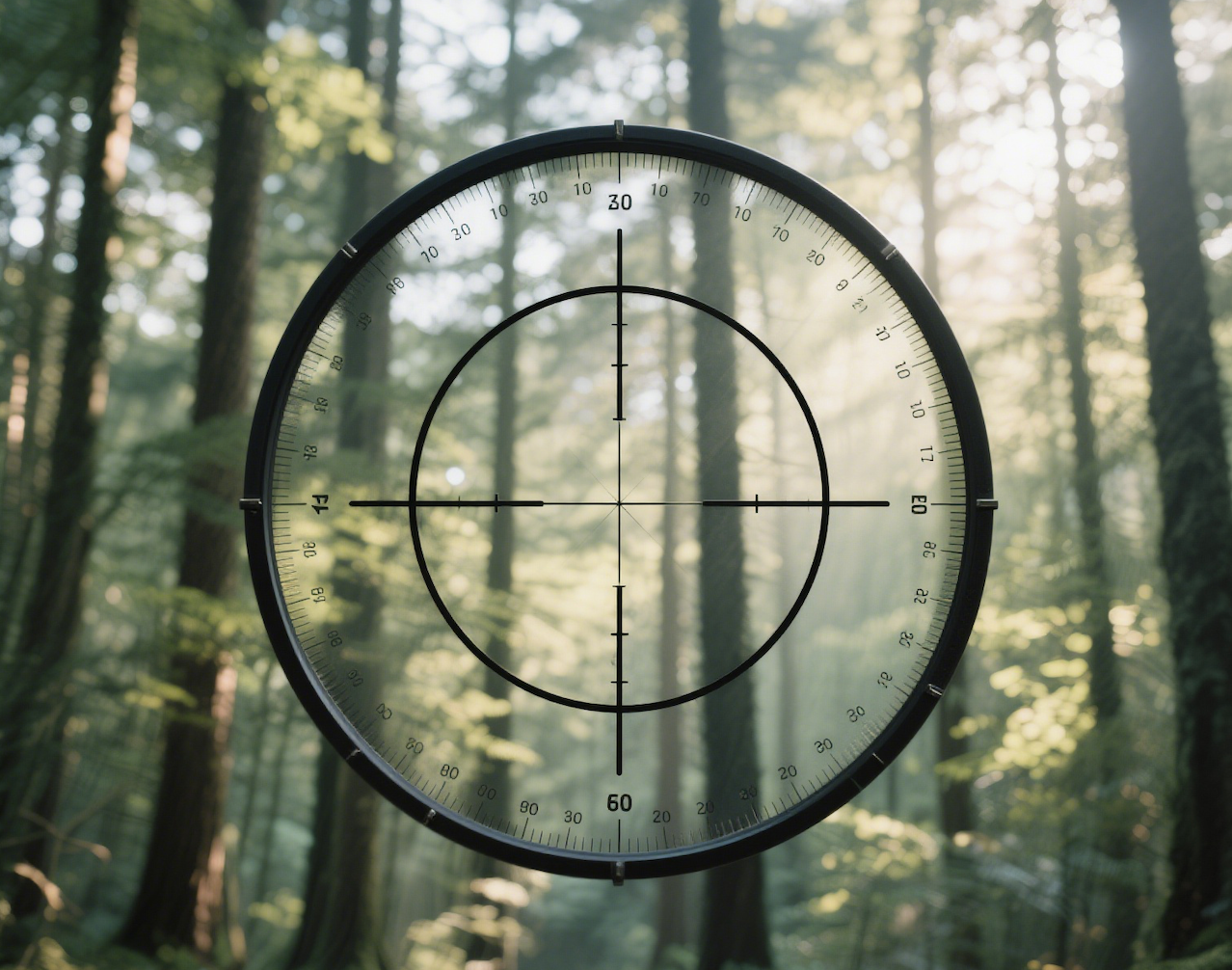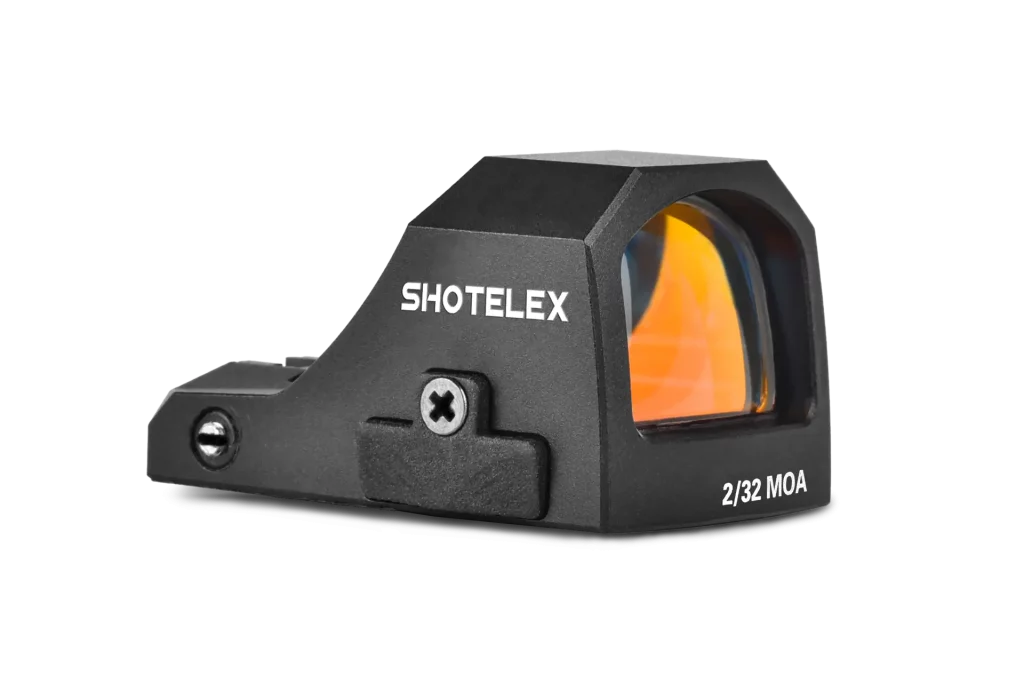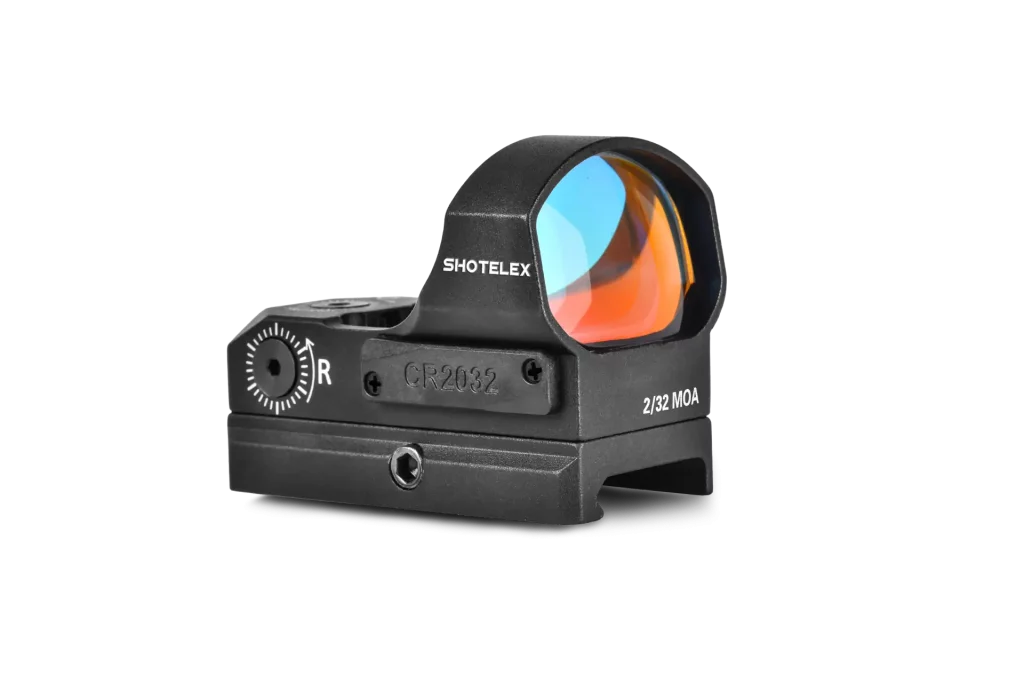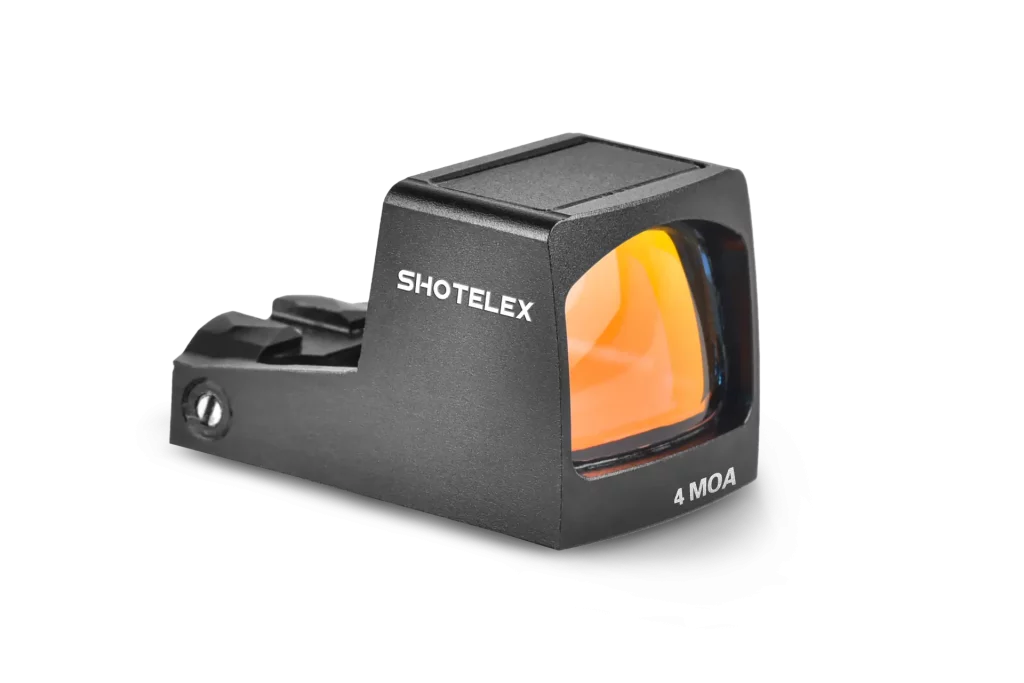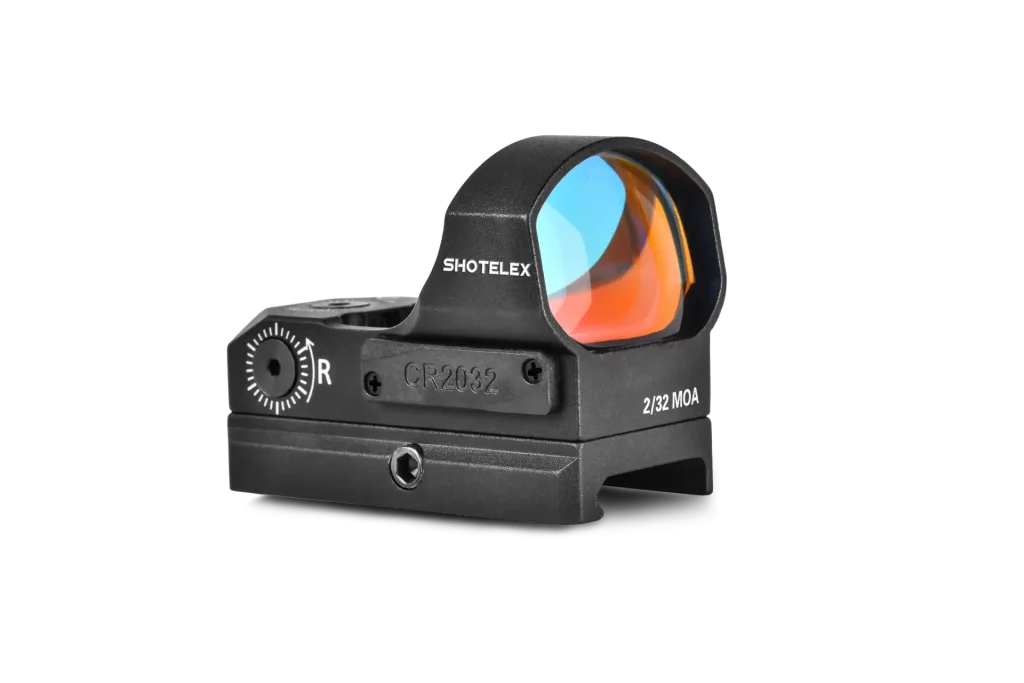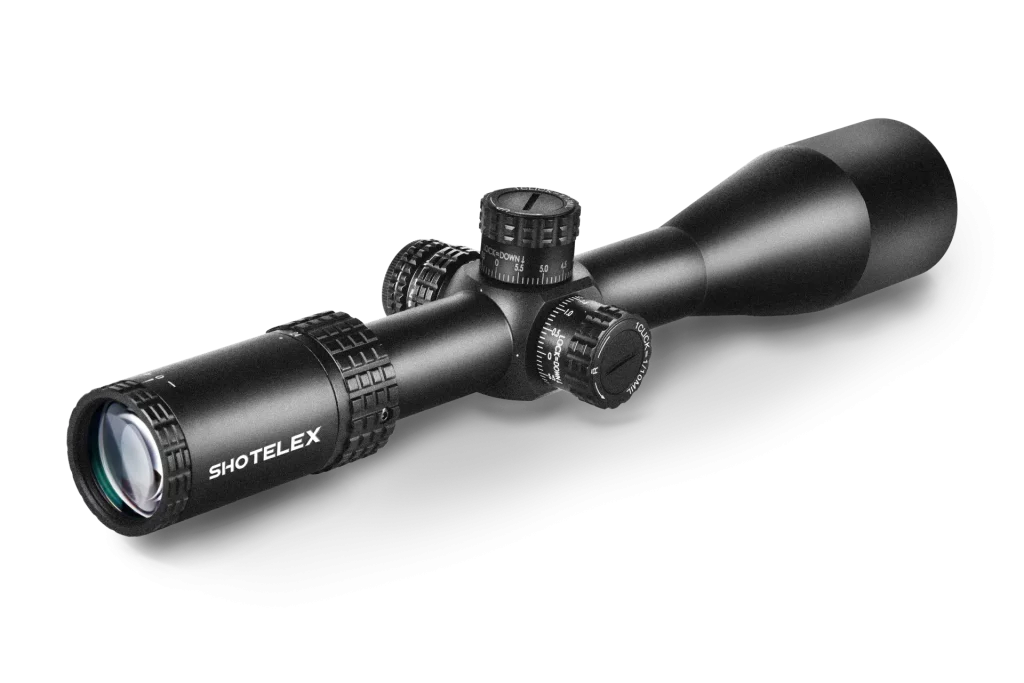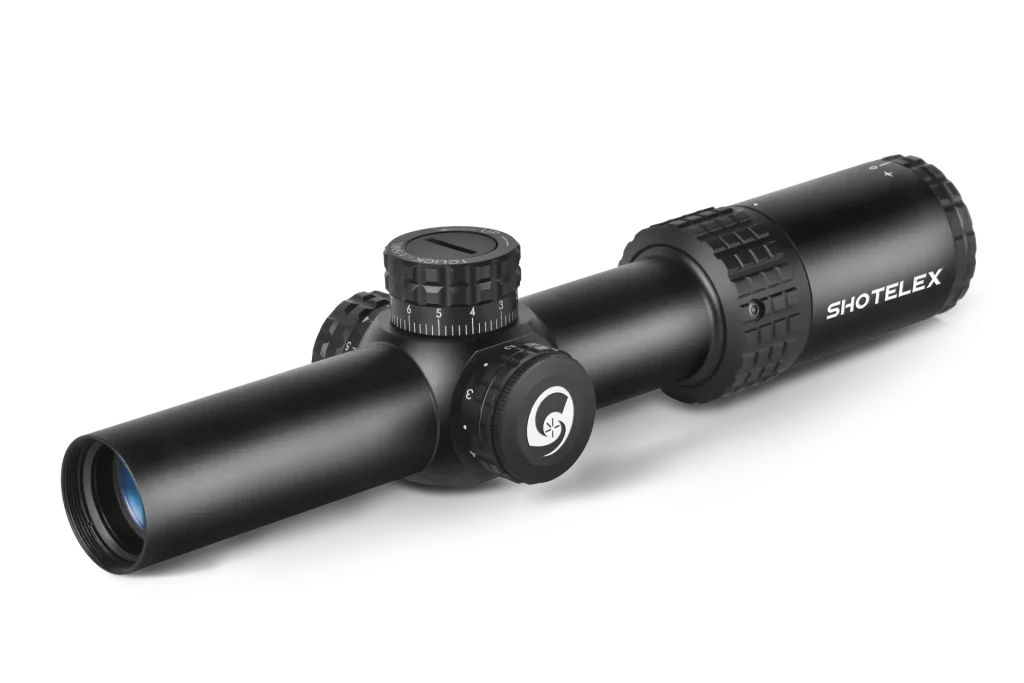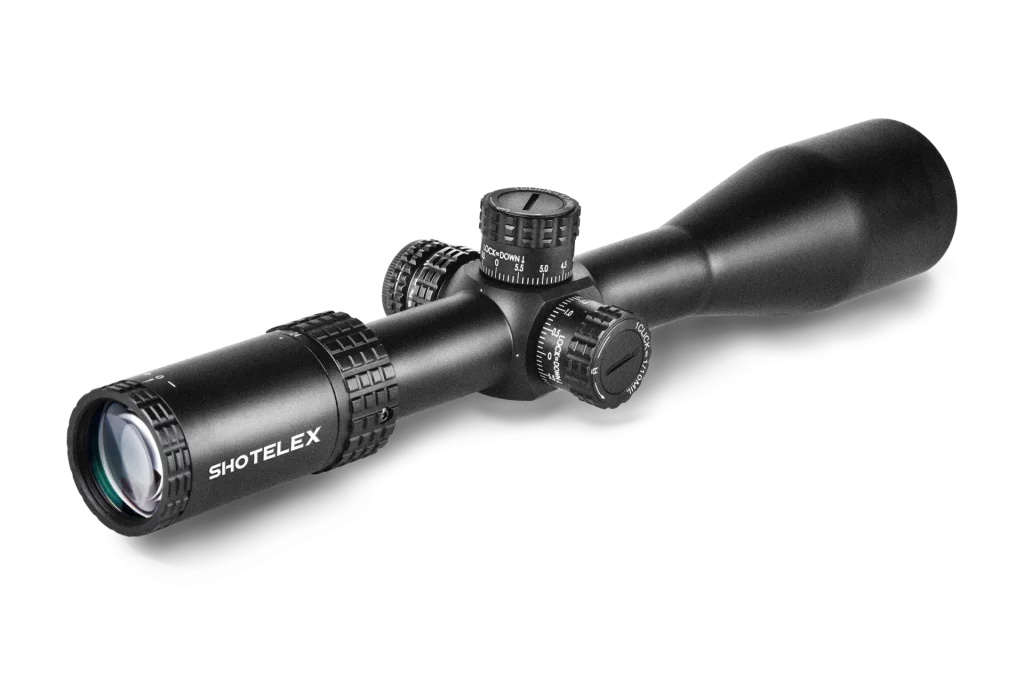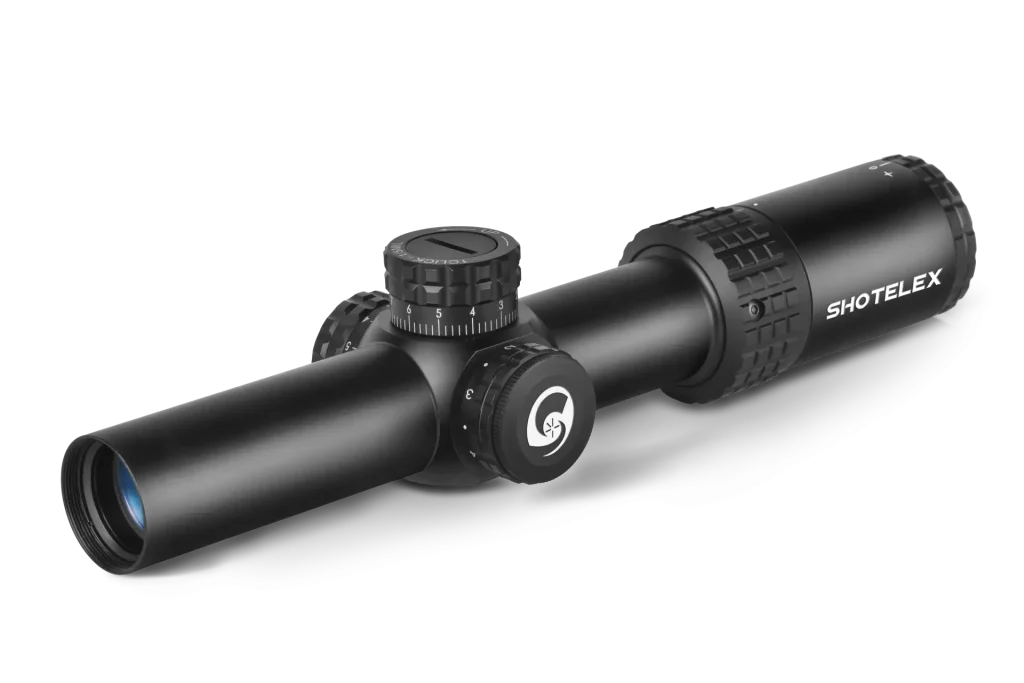What is A Reticle On A Scope?
If you’re new to shooting, you might be wondering: what is a reticle on a scope? Is it just a few simple lines inside the scope? What role does it really play in shooting?
Well, don’t worry! In this article, we’ll be bringing you a closer examination of what a reticle is so that you can better and more clearly understand its function and importance in increasing the accuracy of your shots.
Part 1. What is a Reticle?
Reticle, or crosshair, or aiming point is the shape you observe in a scope that will enable you to point at your target. It is an invisible “ruler” that you can utilize to accurately gauge where the target is, how far away it is, and even gauge wind or bullet drop in more challenging shooting conditions.
There are a lot of varieties of reticles, every one specific to some aim and advantage.
To a newbie to shooting, this will hopefully be confusing, but don’t worry, in the sections that follow, we’ll walk you through all the different types of reticles and how they’re used in depth.
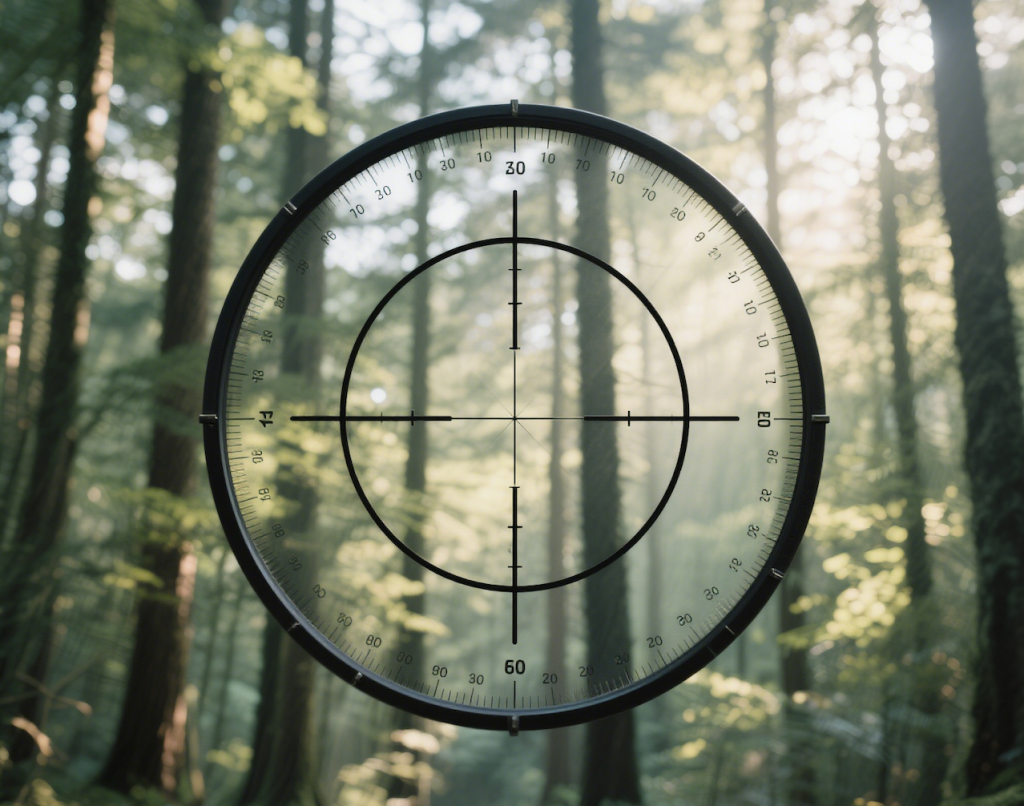
Part 2. Different Types of Reticles
1. Duplex Reticle
Duplex reticle is the oldest and most conventional design. The variant, which has stout outer posts on both of its vertical and horizontal axes tapering progressively to their center for precise crosshairs, can be observed on various weapon systems.
The variation enables the shooter’s eye to align by itself with the crossing point of fine crosshairs for rapid target pick-up as well as good visibility against various backgrounds.
Thick outer perimeters provide added support in conditions of low light or in dense fields, with fine center being such that the targets are not obstructed for effective targeting.
Best For: Beginners; commonly used in hunting deer and for casual shooting. Ideal for mid to short range environments where speed and clarity are crucial.
2. Mil-Dot Reticle
Mil-Dot Reticles utilize an evenly distributed pattern of evenly spaced dots along vertical and horizontal crosshairs, typically representing 1 miliradian at 100 yards. Each dot represents approximately 3.6 inches at that range; using this reticle allows shooters to estimate distance to targets known sizes, calculate bullet drop and compensate for wind drift.
Mil-Dot layout is designed for users trained in range estimation and ballistic correction to perform quickly without external tools.
Advanced grid systems offer even finer adjustments with half-mil spacing for precise adjustments, helping maintain accuracy when engaging targets at different elevations or inclinations angles.
Best For: Long-range shooting and sniping, Tactical training and military use, Professional shooters requiring precise adjustments
3. BDC (Bullet Drop Compensation) Reticle
BDC reticle is created with multiple points of aim (or holdover marks) along the vertical crosshair. These points have already been pre-calibrated for specific bullet drops at specific distances (e.g., 100, 200, 300, 400 yards).
The construction is typically founded on standard calibers like .223 or .308, and the range markers are staggered based on how that bullet drops down range due to gravity.
Some designs include windage markers or dots for crosswind compensation as well. These aiming points allow shooters to quickly shift between different target ranges without manually adjusting turret settings, making the reticle ideal for fast-paced field conditions where time is limited.
Best For: Medium to long-range hunting (e.g., wild boar, antelope), Tactical applications requiring rapid distance adjustments, Ideal for rifles with known ballistic profiles.
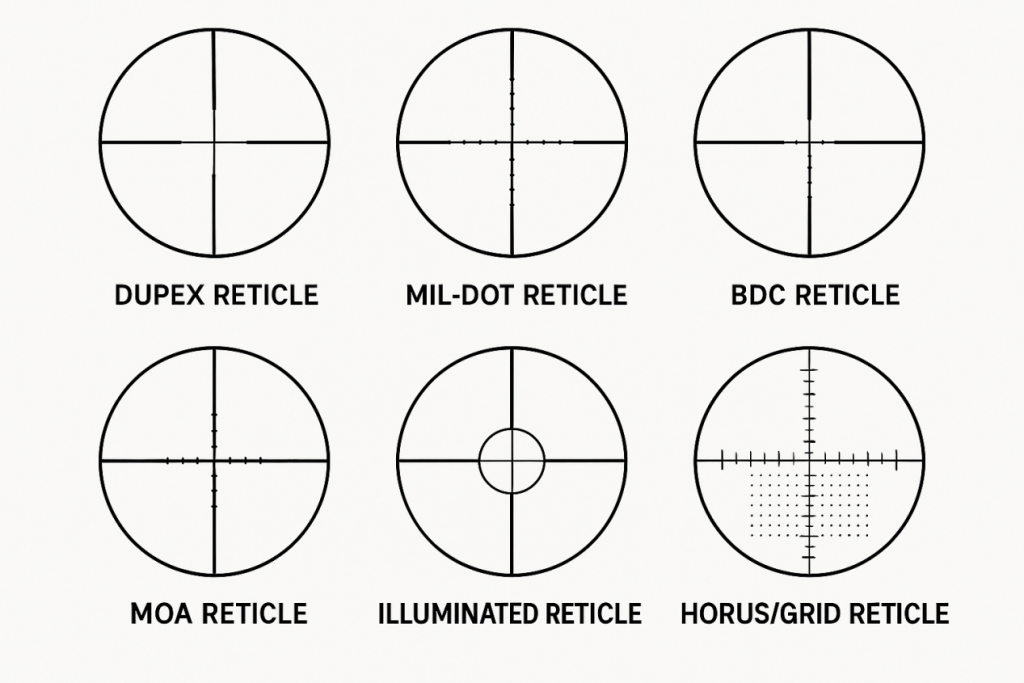
4. MOA (Minute of Angle) Reticle
MOA reticles are graduated in hash marks or dots in MOA increments (usually 1 or 2 MOA per division). One MOA is nearly equal to 1.047 inches at 100 yards, and this angle measure allows a handy means of fine elevation and windage adjustment.
The MOA system is particularly easy for shooters familiar with the imperial system of measurement, as it allows easy relationship between turret adjustment and reticle holdover. Advanced MOA reticles may include sub-tensions for elevation, wind drift, and lead on moving targets. These designs are often used with MOA-adjustable turrets to provide exact corrections during precision shooting.
Best For: Precision and competitive shooting, Shooters who focus on ultimate accuracy, Popular among match-grade optics
5. Illuminated Reticle
Illuminated reticle incorporates internal lighting, usually by LED, fiber optics, or tritium, to light up the crosshairs or specific details of the reticle. Most illuminated scopes offer multiple degrees of brightness and sometimes allow the shooter to change from red, green, or other colors, depending on the intensity of ambient light.
The illumination is especially useful in low-light situations, such as dawn, dusk, dense woods, or indoor photography. Some models automatically compensate for ambient light brightness or have “night vision” friendly modes. Depending on the scope, the entire reticle may be illuminated or only the central aiming point.
Best For: Night hunting (e.g., wild boar), Tactical operations, forest missions, or dawn/dusk use, Environments requiring fast reactions and high contrast
6. Horus/Grid Reticle
The Horus or grid-pattern reticle is a highly complex, precision design featuring a close-spaced matrix of hash marks, dots, and lines covering a large portion of the field of view.
The grid allows real-time holdover, windage, elevation, and even target lead without the need to relocate the scope’s turrets. The layout often includes a central aiming point, secondary aiming marks extending along both axes, and a full grid in the lower quadrants.
These reticles are built for experienced shooters who can interpret data and make manual adjustments on the fly. The design enables users to compensate for multiple ballistic variables at once and even engage multiple targets without resetting the optic.
Best For: Elite sniping and law enforcement, PRS (Precision Rifle Series) and competitive long-range shooting, Complex environments with wind and multiple targets
7. Circle Dot / Red Dot Reticle
This reticle design is a simple illuminated dot, often 2-4 MOA diameter, or a circle around the dot to aid in faster target acquisition. The circle-dot setup, used in reflex or holographic sights, is aimed at fast sight alignment with minimal visual clutter.
These reticles are usually parallax-free and allow shooters to shoot using both eyes open and be completely situationally aware. The circle aids in quick centering, and the center dot provides a fine point of aim.
Many models also offer brightness control and night vision compatibility. Some designs include bullet drop compensation points or range estimation marks integrated subtly into the circle.
Best For: Close-quarters battle (CQB) and tactical engagements, Pistols, shotguns, and AR platforms, Dynamic shooting and fast-reaction scenarios.
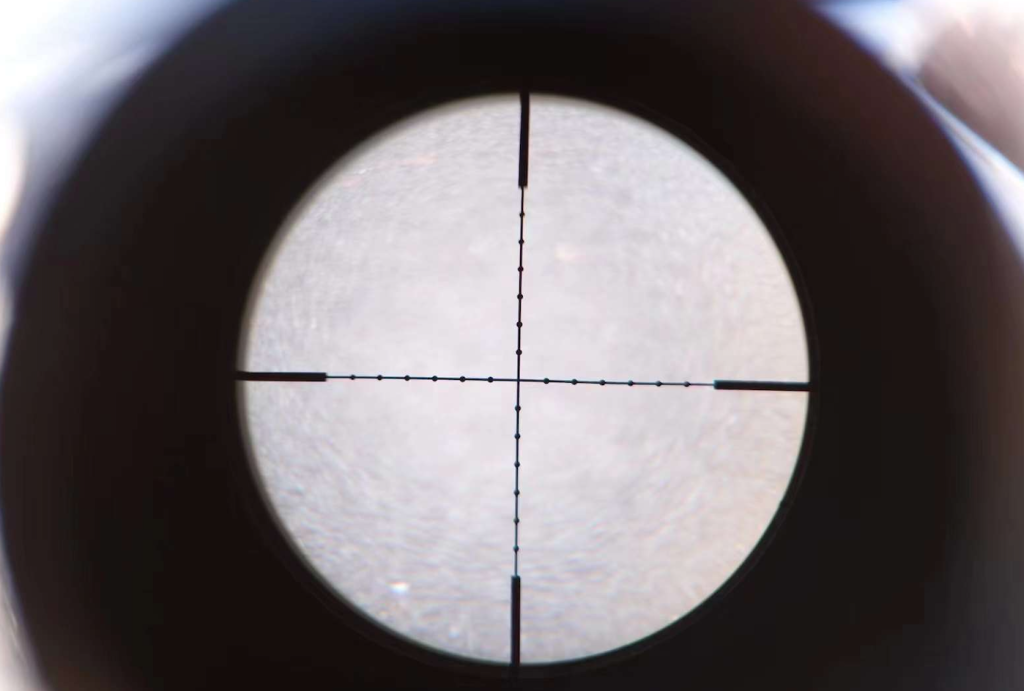
Part 3. Reticle Installation Location: First Focal Plane (FFP) vs. Second Focal Plane (SFP)
Rifle scopes position the reticle on the First Focal Plane (FFP) or the Second Focal Plane (SFP). It has a tremendous impact on how the reticle behaves when you adjust the magnification, and also determines the usefulness of the reticle for range estimation, holdovers, and also ballistic corrections.
1. First Focal Plane (FFP)
The reticle is positioned in front of the magnifying lens group—i.e., inside the scope’s optical system before the zoom lens. As a result, when you adjust the magnification (zoom in or out), the reticle grows proportionally larger together with the target image. This means that at higher magnifications, the reticle will appear larger, and at lower magnifications, smaller, but always in relation to the same size within the gunner’s sight.
Advantages:
- Stable Subtensions: Since the reticle follows magnification, the angular measurements (mils or MOA) are stable at all zooms, allowing precise distance estimation and ballistic correction without re-calibration.
- Ideal for Tactical and Long-Range Target Shooting: FFP scopes are favored by experts and military snipers because they are capable of making trustworthy corrections under all magnifications, enabling quick confident shots under changing conditions.
- Versatility: Suitable for shooting at varied distances where constant switching of magnification helps adapt the field of view and shooting precision.
Considerations:
- At low magnifications, the reticle can appear very small and harder to see clearly, which might be challenging for some users.
- Usually more expensive due to the complexity of optical design.
Typical Use Cases:
- Long-range precision shooting
- Tactical engagements
- Sniper applications
- Competitive shooting disciplines where variable magnification is crucial
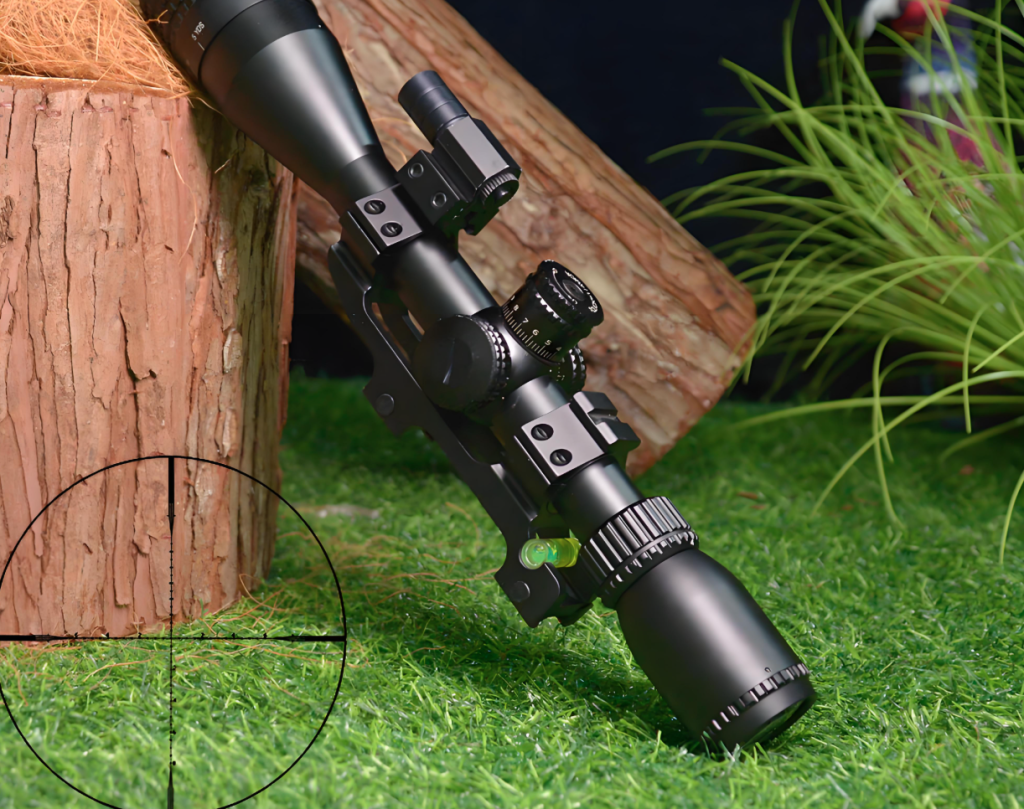
2. Second Focal Plane (SFP)
The reticle is located behind the group of magnification lenses, near the eyepiece. This means that the reticle remains a constant size regardless of the zoom level. If you zoom in or out, the reticle does not change size, remaining the same in low and high power settings.
Advantages:
- Consistent Visual Appearance: The reticle is never thicker or thinner or larger or smaller, which most hunters and recreational shooters prefer as more intuitive and easier to use.
- Enhanced Low-Magnification Clarity: Because the reticle will never seem smaller at lower magnifications, it will stay conspicuous and plainly visible in the field of view of the shooter.
- Typically More Affordable: SFP scopes are generally simpler in design and thus can be more budget-friendly.
- Simplicity: For shooters who use a fixed magnification or rarely adjust zoom, SFP reticles provide a straightforward aiming experience without the complexity of changing reticle subtensions.
Limitations:
Inconsistent Subtensions: Because the reticle size is fixed, the distance between holdover marks (e.g., mil-dots or MOA hash marks) only corresponds accurately to the ballistic measurements at one specific magnification setting (usually the highest or a designated “zero” magnification). At other zoom levels, those markings will not represent true angular measurements, so distance calculations or holdover corrections can be inaccurate.
This means shooters must either memorize which magnification corresponds to the reticle’s ballistic references or limit their use of holdovers to a single zoom level.
Typical Use Cases:
- Hunting, where rapid shot placement is needed without complicated ballistic calculations
- Fixed magnification scopes or low-to-medium zoom scopes where consistent reticle size improves target acquisition
- Users who prefer intuitive, no-fuss aiming without worrying about magnification-dependent subtensions
How to Choose Between FFP and SFP?
Do you require precise ballistic corrections and range estimations across variable magnifications? If yes, First Focal Plane (FFP) is the best choice because your reticle measurements remain accurate regardless of zoom.
Do you prioritize simplicity, quick target acquisition, and use mostly fixed or low magnifications? Then Second Focal Plane (SFP) will serve you better, providing a stable reticle size for easier aiming.
Budget and preference also play a role: FFP scopes tend to be pricier and more complex, while SFP scopes are often more affordable and user-friendly for general shooting and hunting.
Summary
What is a reticle on scope? In simple language, it’s the “map” you see through your scope that helps you acquire your target exactly. Choosing the right reticle for your shooting condition and your needs can be a huge difference to your shooting efficiency and accuracy.
New shooter or not, an understanding and use of your reticle will help you get the most out of your scope.

